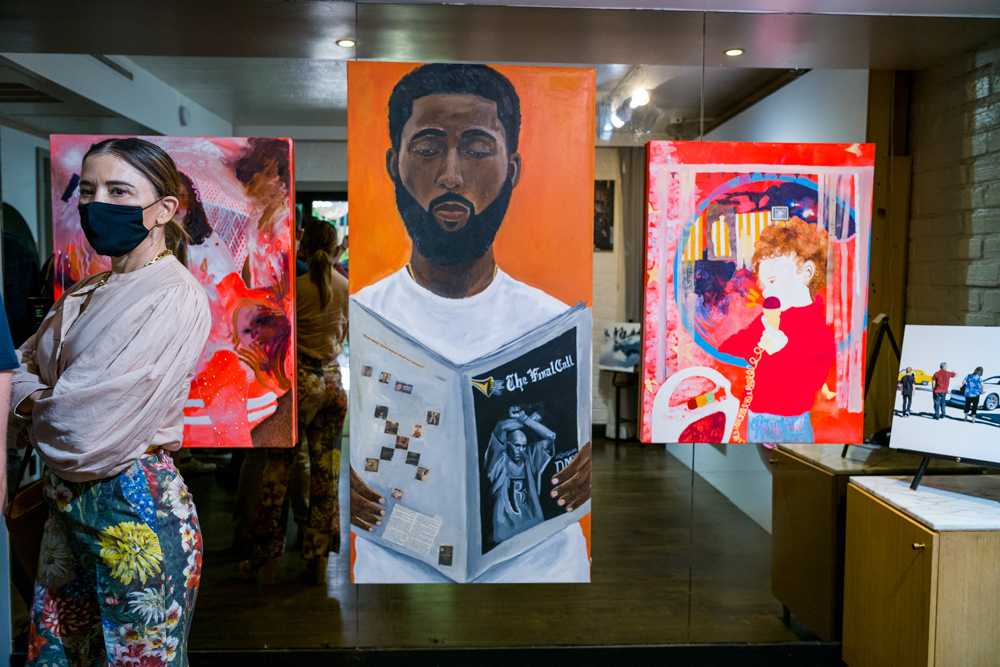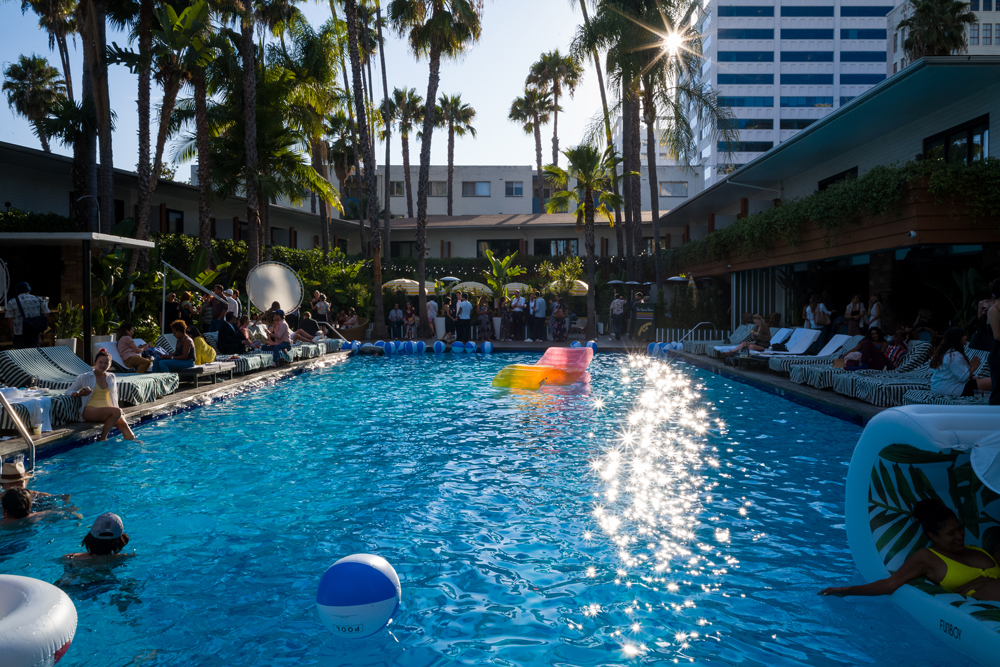Felix LA, the fair that for two years has run concurrently with Frieze LA, is once again at the Roosevelt from July 29 through August 1. This time it is going up without the auspices of the larger Frieze fair, which first delayed in February, then fully cancelled in July. To keep to the current code, all booths will also be held in the open-air cabanas, or in the downstairs rooms that open up their wide windows to the pool, which has a David Hockney painted on the bottom. Though the gallery lineup has narrowed in scope to a handpicked 29 local Los Angeles galleries (down from 60 last year), several major LA dealers —many of whom were planning to do Frieze—will be showing at Felix for the first time. “After a year of so many challenges, we’re happy to present a strictly LA edition of Felix that celebrates our community’s emergence from pandemic isolation. We hope this edition of Felix will mark a turning point for in-person events in Los Angeles, and serve as a catalyst for a recharged and re-energized art world to emerge,” said Felix LA co-founders Dean Valentine, Al Morán and Mills Morán via Cultural Counsel. Felix fair coincides with the inaugural Gallery Weekend Los Angeles, organized by the fledgling Gallery Association of Los Angeles, which was launched in May 2020 as a support network for galleries during the pandemic shutdowns.

Gagosian Gallery
It is the first major art show in Los Angeles in almost 16 months (running simultaneously with LA Art Show at the Convention Center) and despite the poolside chill evoked by the cabana layout, there’s a frenetic energy that speaks to the anxiety of the past year. While certain blue-chip galleries thrived during the pandemic—notably David Zwirner and Rele Gallery both opened spaces in Los Angeles in the past year; Gagosian took over the former Marciano Museum—a report from last March stated that approximately a quarter of galleries had to cut part-time staffers or furlough employees, nearly 89% had a decline in sales, and 46% had in-progress sales canceled. At the time it was projected that a third of the city’s galleries would have to close. Though this weekend is not expected to make up for the loss of Frieze LA, the fair aims to draw in collectors hungry to view, talk about, and purchase art in person after a year of online “viewing rooms.” Gallery owner Mihai Nicodim stated that the fair is “as much about community as it is about commerce,” and press releases from Felix LA have emphasized a primary goal of fostering connoisseurship, collaboration and community.
The vision of a Los Angeles-wide arts community is rather hard to pin down, however, something that becomes obvious as one walks between the eclectic offerings of the cabanas. Though many galleries chose to highlight pieces by LA-based artists, there’s an enormous range in both the galleries present—which vary from international shakers like Gagosian, to smaller local spaces like Various Small Fires—and the work itself. Many rooms highlight artists from Los Angeles. Though each cabana has essentially the same layout, the different installation tactics undertaken by the galleries lent itself to an effect that was far from uniform.

Charlie James Gallery
Galleries that emphasized only one or two artists had a more powerful effect. The cohesion produced by focusing on a more unified body of work made a reprieve from the disorientation of the long hallways and identical doorways, which, more than once, I found myself walking out of in the wrong direction (luckily, the Hollywood Roosevelt’s large framed photographs by Slim Aarons, placed at even intervals down the hallway, would quickly right my path. Aha! I had already seen the portrait of San Vicenzo!). Of particular note: Calvin Marcus at David Kordansky Gallery, whose bright, lush, carnivorous-like “Begonia” series exploded from one large canvas to the next, with thankfully little interruption along the walls; Parker Gallery’s exhibition of painter Thornton Dial’s colorful yet harmonized canvases and “ecstatic form” ceramicist Melvino Garetti; Ishi Glinsky’s pieces at Chris Sharp Gallery, whose luminous sculptures of old cartoon characters such as the Pink Panther and Mickey Mouse comes from jewelry inlay techniques from Indigenous tribes of the US Southwest; Jonathan Wateridge at Nino Mier, whose large portraits depict swimmers and pool-side loungers in the muted, gray-toned heaviness of a humid day; and Sara Issakharian’s oneiric canvases at Tanya Leighton.

Anat Ebgi gallery
The hotel-room-as-gallery poses a number of practical challenges. Light and wall space are limited, and an unfortunate number of paintings end up propped up on the mantle, above the minibar, or over the bathroom toilet. Now that the art has left the digital sphere, it gives the impression of appearing willy-nilly, as though it materialized in a cabana room of the Hollywood Roosevelt due to a matrix glitch. Some mysterious shared instinct led many gallerists to place sculptures in the shower of the bathrooms, where they cohabitated with phone chargers and scented candles. It worked surprisingly well for Greg Ito’s The Guardian at Anat Ebgi Gallery, a cast resin sculpture of a peacock whose tail feathers are outlined by pink neon light. It glows against the tile walls before one sees the incongruous light source, like some kind of alien crash landed on earth. The magisterial bird, which is molded less for realism than as a film prop, fits right in with the hotel, as does the neon. Over at Kohn Gallery, a dealer explained that “the diagrams the fair provided gave you a sense of the space but weren’t exact, so we had to do a lot of troubleshooting.” One solution? Switching out the television to install a Martha Alf painting, which “actually has received a lot of positive attention” in this new location.

Residency Art Gallery
Individual pieces did best when they interacted with the aura of the Hollywood Roosevelt, instead of working against it. Though hotels are often touted as bland liminal spaces par excellence, the heightened perception that is brought on by looking at work extends, as well, to the cabana rooms. Nevine Mahmoud’s “Wax Lips Seated” at M+B, a sculpture of bloated, ketchup red lips propped onto a plastic deck chair, fit right in; at Various Small Fires, Glen Wilson’s “Alchemy”—in which a chain link fence was interwoven with a reproduced image of young Black boys splashing in the surf, was completely arresting in the midst of the busy fair. One of the most captivating pieces is part of a phenomenal offering from Roberts Projects, Finding a Peace of Mind by Dominic Chambers. In shades of brilliant red, a woman reads attentively. “Reading is a kind of transportation to a different space, which fits with the setting […] literature can be a kind of escapism,” Chambers said. As the lights switched on in the pool, it began to give off a warm blue glow, while the sky turned blush-colored. California, well known as a haven for painters obsessed with light, seems equally well-suited to pieces that focus on color. Chambers is not from Los Angeles, though his gallery is—he’s staying for the duration of the show at one of the rooms at the Hollywood Roosevelt, a few floors above the buzz of the cabanas.
All Photos by Mike Vitelli. Courtesy of Felix LA.


